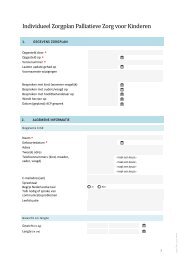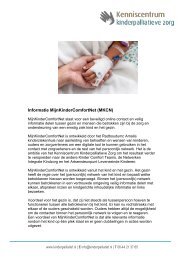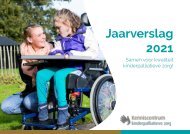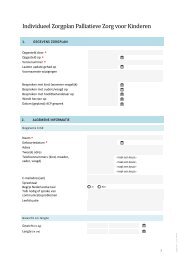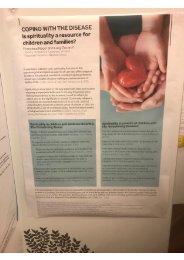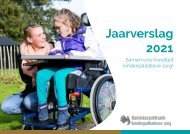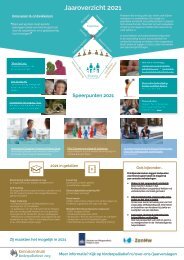EAPC Atlas of Palliative Care in Europe 2019
Conclusion: PC health policies developed in recent years have promoted vigorous development across Europe. Preliminary data on the integration of PC into different fields are encouraging though inequalities between countries and sub-regions persist. Further comparative analysis exploring factors leading to uneven progress may inform strategies to provide PC for all people in need. Per land is de stand van zaken van de (kinder)palliatieve zorg weergegeven.
Conclusion: PC health policies developed in recent years have promoted vigorous development across Europe. Preliminary data on the integration of PC into different fields are encouraging though inequalities between countries and sub-regions persist. Further comparative analysis exploring factors leading to uneven progress may inform strategies to provide PC for all people in need.
Per land is de stand van zaken van de (kinder)palliatieve zorg weergegeven.
Create successful ePaper yourself
Turn your PDF publications into a flip-book with our unique Google optimized e-Paper software.
Chapter 9. Integration <strong>of</strong> <strong>Palliative</strong><br />
<strong>Care</strong> at the Primary <strong>Care</strong> level<br />
EUROPEAN CONTEXT<br />
B<br />
TECHNICAL DATA<br />
ON THE <strong>2019</strong> <strong>EAPC</strong><br />
SURVEY ON PALLIATIVE<br />
CARE AT THE PRIMARY<br />
CARE LEVEL<br />
Population: 54 countries <strong>of</strong> the<br />
<strong>Europe</strong> WHO region and Lichtenste<strong>in</strong>.<br />
Survey Details<br />
Areas explored: 5 ma<strong>in</strong> health<br />
<strong>in</strong>dicators: identification <strong>of</strong> PC<br />
patients at the primary care level<br />
and months before death cared for,<br />
<strong>in</strong>centives to the identification <strong>of</strong> PC<br />
patients, <strong>of</strong>ficial policy documents<br />
on primary PC (laws or strategies/<br />
plans/policies), primary palliative<br />
care education, and the denom<strong>in</strong>ation<br />
<strong>of</strong> doctors at the primary<br />
care level.<br />
Questionnaire: on-l<strong>in</strong>e survey, 10<br />
questions, answered <strong>in</strong> (average)<br />
16 m<strong>in</strong>utes.<br />
Participants: 52 national experts on<br />
Primary <strong>Palliative</strong> <strong>Care</strong> and PC.<br />
Pr<strong>of</strong>ile <strong>of</strong> experts (affiliation):<br />
22 PC experts, 15 primary care<br />
experts, 11 academicians, and<br />
4 NGOs or Oncology Centres´experts.<br />
Coverage: 34/54 countries<br />
(63%): with one respondent<br />
22/34 (65%) countries and with<br />
two or more respondents 12/34<br />
(35%) countries.<br />
Data collection: 12/2018 to<br />
3/<strong>2019</strong> (4 months).<br />
Project Management: ATLANTES<br />
Research Group, Institute for Culture<br />
and Society, University <strong>of</strong> Navarra,<br />
Pamplona (Navarra), Spa<strong>in</strong> .<br />
Scientific Advice: Scott Murray<br />
(United K<strong>in</strong>gdom), Sébastien Mo<strong>in</strong>e<br />
(France).<br />
Promotor: <strong>Europe</strong>an Association<br />
for <strong>Palliative</strong> <strong>Care</strong> (<strong>EAPC</strong>).<br />
PALLIATIVE care provision <strong>in</strong> <strong>Europe</strong><br />
ONLY reaches a small proportion<br />
<strong>of</strong> the population and varies<br />
GREATLY depend<strong>in</strong>g on the disease,<br />
PATIENT’s stage <strong>of</strong> the illness, and<br />
geographical context.<br />
Part <strong>of</strong> this variation <strong>in</strong> coverage<br />
could be ameliorated by partner<strong>in</strong>g<br />
with primary care providers,<br />
who <strong>of</strong>ten already play a major role<br />
<strong>in</strong> provid<strong>in</strong>g palliative care. Partnership with<br />
primary care providers could improve early<br />
identification <strong>of</strong> patients eligible for palliative<br />
care, strengthen cont<strong>in</strong>uity among various levels<br />
<strong>of</strong> care, and provide greater access to person-centred<br />
care.<br />
The <strong>Europe</strong>an Association for <strong>Palliative</strong> <strong>Care</strong><br />
Primary <strong>Care</strong> Reference Group and the World<br />
Health Organisation share the conviction that<br />
a coord<strong>in</strong>ated primary care and public health<br />
approach is necessary to ga<strong>in</strong> universal coverage<br />
and early access to palliative care <strong>in</strong> the<br />
community (1, 2, 3, 4).<br />
Identify<strong>in</strong>g PC patients<br />
at the primary level<br />
Although we know that more patients receive<br />
palliative care by primary care staff than by<br />
palliative care specialists <strong>in</strong> hospices and the<br />
community, only 12 countries reported primary<br />
care teams identify<strong>in</strong>g more than 20%<br />
<strong>of</strong> their patients for palliative care before they<br />
died (across all diseases). Three countries (F<strong>in</strong>land,<br />
Poland, and The Netherlands) report the<br />
highest proportions <strong>of</strong> palliative care needs<br />
identified at the primary care level, rang<strong>in</strong>g<br />
from 61 to 80%.<br />
The average number <strong>of</strong> months before death<br />
that patients are cared for by primary care pr<strong>of</strong>essionals<br />
ranges from one week to one month<br />
(11/34 countries, 32%), and one month to six<br />
months (12/34 countries, 35%). Germany and<br />
Switzerland report better figures that range from<br />
six months to one year or over.<br />
Eduardo Garralda, Scott Murray, Sébastien Mo<strong>in</strong>e.<br />
Some <strong>Europe</strong>an countries promote the identification<br />
<strong>of</strong> palliative care need through <strong>in</strong>centives<br />
for primary health pr<strong>of</strong>essionals. However, there<br />
is no clear correlation between <strong>in</strong>centives and<br />
proportion <strong>of</strong> patients <strong>in</strong> need <strong>of</strong> palliative care<br />
identified at the primary care level. In fact, up<br />
to 10/34 countries (29%) have at least some<br />
sort <strong>of</strong> <strong>in</strong>centive system <strong>in</strong> the form <strong>of</strong> economic<br />
compensation (the most common), academic/<br />
curricular awards, or time <strong>of</strong>f, such as free days,<br />
extra hours <strong>of</strong> leave, or early leaves.<br />
Official documents regulat<strong>in</strong>g<br />
Primary PC provision<br />
<strong>Palliative</strong> care is <strong>in</strong>cluded <strong>in</strong> primary care <strong>of</strong>ficial<br />
documents: 31/34 <strong>Europe</strong>an countries (92%)<br />
at least specifically mention palliative care provision<br />
with<strong>in</strong> these documents. Specifically, 20<br />
countries have a national or regional law (38%)<br />
and 22 report a national or regional plan/strategy/policy<br />
specifically mention<strong>in</strong>g PC provision<br />
at the primary care level. Other types <strong>of</strong> <strong>of</strong>ficial<br />
documents <strong>in</strong>clude cl<strong>in</strong>ical guidel<strong>in</strong>es, orders<br />
<strong>of</strong> the M<strong>in</strong>istry <strong>of</strong> Health (Kyrgyzstan), national<br />
quality frameworks, and position papers on<br />
palliative care (The Netherlands).<br />
Primary PC education<br />
<strong>in</strong> Medical Schools<br />
Inclusion <strong>of</strong> palliative care at the primary care<br />
level <strong>in</strong> undergraduate <strong>in</strong>stitutions is documented<br />
<strong>in</strong> 21 countries (62%). However, this varies<br />
greatly from country-to-country. For example,<br />
12 countries teach palliative care at the primary<br />
care level <strong>in</strong> all medical schools, two countries <strong>in</strong><br />
half <strong>of</strong> medical schools, and seven countries <strong>in</strong><br />
less than a 40% <strong>of</strong> their medical schools. Variations<br />
are even bigger if we look at the number <strong>of</strong><br />
dedicated hours, medical schools where these<br />
components are mandatory, and when tak<strong>in</strong>g<br />
<strong>in</strong>to account a lack <strong>of</strong> <strong>of</strong>ficial, up-to-date <strong>in</strong>formation.<br />
Generally, residency programs for family<br />
physicians <strong>in</strong>corporates some palliative care<br />
tra<strong>in</strong><strong>in</strong>g <strong>in</strong> 22 countries (65%), and 17 countries<br />
(50%) report hav<strong>in</strong>g these components <strong>in</strong>cluded<br />
<strong>in</strong> the tra<strong>in</strong><strong>in</strong>g for general physicians (GPs).<br />
<strong>EAPC</strong> <strong>Atlas</strong> <strong>of</strong> <strong>Palliative</strong> <strong>Care</strong> <strong>in</strong> <strong>Europe</strong><br />
81




